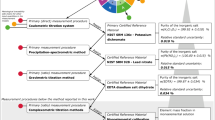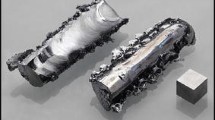Abstract
The activities of oxygen in liquid lead and liquid antimony were measured for the temperature range of 1073 to 1323 and 973 to 1123 K, respectively, using the following electrochemical cell:
in liquid Pb or Sb/ZrO2(+CaO)/Air, Pt. After measuring the equilibrium emf, the liquid metal was deoxidized by imposing a preselected voltage on the electrodes. The fairly low oxygen concentration in liquid metal could be easily determined by a modified analysis of the quantity of electrical charge passing through the cell. The standard free energies of solution of oxygen in liquid lead and liquid antominy for the reaction of l/2 O2 → O (1 at. pct) were determined respectively to be: ΔG° (in Pb) = −28,300 + 3.38T (± 300) cal/g-atom = −118,600 + 14.1T (± 1300) J/g-atom, ΔG° (in Sb) = −32,880 + 5.20T (± 350) cal/g-atom = −137,600 + 21.8T (± 1500) j/g-atom, where the reference state for dissolved oxygen was an infinitely dilute solution.
Similar content being viewed by others
References
C. B. Alcock and T. N. Beiford:Trans. Faraday Soc, 1964, vol. 60, p. 822–35.
T. N. Belford and C. B. Alcock:Trans. Faraday Soc, 1965, vol. 61, p. 443–53.
H. Rickert and H. Wagner:Electrochim, Acta, 1966, vol. 11, p. 83–91.
K. E. Oberg, L. M. Friedman, W. M. Boorstein, and R. A. Rapp:Met. Trans., 1973, vol. 4, p. 61–67.
T. A. Ramanarayanan and R. A. Rapp:Met. Trans., 1972, vol. 3, p. 3239–46.
R. Szwarc, K. E. Oberg, and R. A. Rapp:High Temp. Sci, 1972, vol. 4, p. 347–56.
W. A. Fischer and W. Ackerman:Arch. Eisenhuettenwes, 1966, vol. 37, p. 697–700.
H. Charle and J. Osterwald:Z. Phys. Chem. N. F., 1976, vol. 99, p. 199–208.
K. T. Jacob and J. H. E. Jeffes:Trans. Inst. Min. Metall, 1971, vol. 80, p. 32–41.
J. W. Patterson, E. C. Bogren, and R. A. Rapp:J. Electrochem. Soc, 1967, vol. 114, p. 752–58.
S. Otsuka: Master Thesis, Faculty of Engineering, Osaka University, 1972.
L. M. Friedman, K. E. Oberg, W. M. Boorstein, and R. A. Rapp:Met. Trans., 1973, vol. 4, p. 69–74.
S. Otsuka and Z. Kozuka: Unpublished research, Osaka Univ., Osaka, 1977.
B. Isecke and J. Osterwald: private communication, Tech. Univ. Berlin, March 1978.
T. Takahashi, H. Iwahara, and I. Ito:Denki Kagaku, 1970, vol. 38, p. 288–93.
Author information
Authors and Affiliations
Additional information
An erratum to this article is available at http://dx.doi.org/10.1007/BF02668418.
Rights and permissions
About this article
Cite this article
Otsuka, S., Kozuka, Z. Activities of oxygen in liquid lead and antimony from electrochemical measurements. Metall Trans B 10, 565–574 (1979). https://doi.org/10.1007/BF02662559
Received:
Issue Date:
DOI: https://doi.org/10.1007/BF02662559




